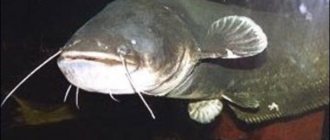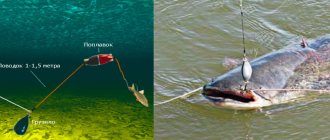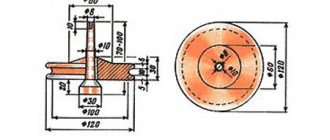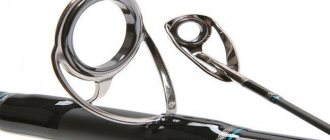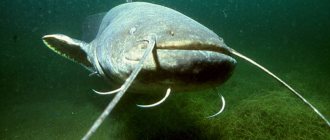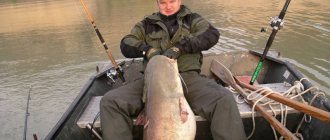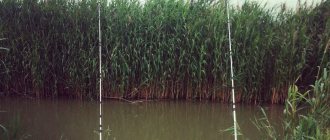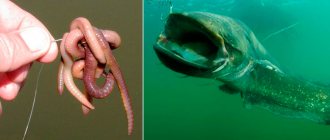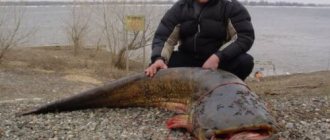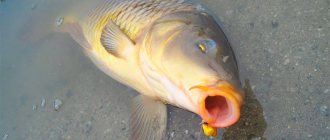Catfishing is considered one of the most exciting types of fishing. This fish, the largest representative of the family of the same name, is impressive in its size, which is why, having caught it, hunters experience incredible pride and pleasure.
The length of its body can reach five meters, while the weight of individual individuals is more than three hundred kilograms. The catfish lives in reservoirs in the European part of our country. It spawns in spring in coastal aquatic vegetation. Females lay eggs in the nest, and males guard them.
The choice of place for fishing for this large predator depends not only on weather conditions, but also on the time of year and even the day.
Fishing in spring
When the catfish awakens after hibernation, the water is heated to only eight degrees. At this time, the fish remains very sluggish, although there is a chance to catch it. You need to find the warmest place on the reservoir - coastal shallows or the mouths of small rivers, next to which there is depth. It is from there that this predator comes out to hunt.
When the water warms up to fifteen degrees, the catfish begins to eat. At this time, he does not understand the choice of prey, rushing at everything that can be eaten. Therefore, in the spring, fishing with artificial bait is very productive.
Fishing in summer
When reservoirs warm up to twenty degrees, it is time for catfish to spawn. It lasts up to three weeks. At this time, mostly small specimens are caught on the bait, but after the end of the spawn, during the feast, fishermen have the most freedom.
Towards mid-July, catfish become active in the evening, at night or early morning, when they hunt closer to the surface. Its presence can be determined by powerful splashes or a peculiar slurping sound. If the water in the reservoir is muddy, then this mustachioed predator can be active all day, and before a thunderstorm it completely forgets about the danger, actively and intensively hunting.
Autumn fishing
When the season of rain and cold weather arrives, it becomes very difficult to guess the location and hunting time of this fish. The hours she goes out to look for food may change every day.
Therefore, for many novice anglers, catching catfish in the fall is somewhat difficult. They often return home empty-handed. Catfish can feed both on quiet nights, preparing for hibernation, and on foggy and cloudy days.
It is difficult to name the exact time of its feeding or biting. However, experienced fishermen know how to catch catfish in the fall. A good guide this season can be those places where there are bream, chub and other small fish. Catfish will definitely be nearby. After the onset of the first frost, it begins to go to the wintering pits, but continues to feed from them. Just like in the spring, fishing for catfish in the fall during this period can be very difficult. Production is already less active.
Tackle and bait for catching catfish in autumn
Fishing for catfish is effective when using most gear, the main condition being the high strength of the rod.
In fishing circles, it is customary to make the following types of tackle for catfish:
- feeder. Actively and effectively used in September and the first half of October. Ideal for fishing in small and medium-sized reservoirs with great depth. The feeder is always based on a feeder - this is an effective bait for catfish in the fall. Cut fish, frog or crayfish meat are used as bait. It is better to use live bait. Mainly used during daytime fishing, although it is also effective at night. It is important to tie the tackle to a tree, otherwise it will be tangled and torn;
- spinning tackle. When using a wobbler or spinner when fishing with a spinning rod, you should not count on a large catch. The only way to catch a catfish is to move next to the fish, since it will not chase its prey. Used in late autumn if the location of the prey is reliably known. With precise casts, a spinning rod can provide a huge catch; a sleepy predator will willingly swallow the prey that is under its nose. Due to torpor, other individuals do not leave their place. It is better to use long spinners or large wobblers with a light color;
Read more
Reliable survival units
You can catch catfish in open water in the fall using any tackle that is durable and has a hook.
- Donka. Catching catfish in the fall on a donk is possible before the ice forms, but knowing the habitat of the predator - even in winter. In autumn, the best time for fishing is at night. To increase the chances of getting a catch, 3-4 donks are cast at night and the gear is checked at dawn. They must first be fixed to pegs, a tree or a bush. In fishing stores there are additional devices - shock absorbers, they are attached to a tree, the fish struggles with the rubber and gets tired, and the fisherman just needs to remove the catch;
- kwok. Nodding involves hitting the water with a special device; it makes a sound that attracts prey. Fishing with quok in the fall is done using a cord with leashes and hooks, which is attached to the boat (can be attached directly to the quok). There are many varieties of quok, there are wooden, metal, homemade from a tin can, bull horn, etc. The active bite occurs on the quok only during the heat - September and half of October, after the cold weather the technique remains ineffective;
- transfer It is used exclusively on small rivers, where the tackle can be secured on both sides. This tackle is a high-strength cord on which leashes are attached. The number of leashes is determined by the fisherman independently, but it is important to maintain a distance between them that will prevent entanglement. Larger fish are caught at night, so the line is set before sunset and retrieved in the morning.
The predator has no obvious preferences regarding baits; all baits of animal origin perform well, live ones are better.
Bait for catfish in the fall:
- live bait;
- worms, baited in 3-7 pieces, used during feeder fishing;
- frog meat or live frogs;
- cancer, attracts prey well during the molting process;
- crawling worm;
- carcasses of small birds, especially fried ones;
- bird offal.
Catfish are not picky about food, the main thing is that it is of animal origin
Catching catfish using kwok
In autumn, this simple device, in skillful hands, produces specific sounds, as if attracting a mustachioed predator to itself like a magnet. Most often, kwok is made from hardwood: maple, ide or apple. The correct sounds to attract prey depend on various factors: the shape of the device, the material, as well as the skill and experience of the fisherman. Catching catfish in the fall with a quok should take place without unnecessary splashes and splashes. Privada should not scare away, but rather attract. Therefore, for a good catch, some training is required.
You need to squawk measuredly - up to three beats with pauses of a few seconds. The equipment for such fishing and the equipment used to catch catfish on a donk in the fall are very similar - this is a powerful rod, a multiplier reel, thick braid from 0.6-0.8 millimeters, a hundred-gram sinker, a leash about sixty centimeters long, a power swivel and impressive treble hook.
Donkey fishing
If the catfish habitat is located close to the shore, you can use traditional gear from local fishermen. These are very powerful donks that are more like livestock tethers. I once managed to observe how local fishermen were hunting for large catfish. Their tackle was especially impressive.
A reel was made from a piece of board, onto which a nylon rope was wound. At the end of this peculiar main fishing line, a hammer without a handle weighing 600 g was tied. A meter from such a sinker there was a leash consisting of a piece of monofilament 0.8-1.0 mm thick and a huge homemade hook. Even higher (about 1 m) a second leash with similar parameters was tied. A stick was used for casting, and the remaining part of the tackle on the shore was attached to a tree trunk. After setting up the fishing rod, the anglers drank, ate, talked and went home. In the morning there was a decent catfish on one of these donks. It was impossible to watch the giant fight without laughing. Two fishermen, throwing a rope over their shoulders, began to pull out their catch like barge haulers. A few minutes later, a mustachioed predator weighing about 20 kg rolled over on the shore.
The most popular tackle
Catching catfish using a donk is especially common among amateurs. In autumn, this type of fishing gives good results. Donka is easy to perform, in addition, it is more reliable than a spinning rod. In addition, it has one big advantage - affordability. For example, one branded spinning rod costs the same as thirty donks.
Many anglers are very successful in catching this mustachioed predator using the most common models. After all, it’s much easier to catch, track bites, and fish with a donkey. In addition, it has more “tricks” than spinning rods.
Catching catfish on a donk in the fall begins the day before the actual fishing. First you need to get crawlers and bears. With this gear, catfish are usually caught starting at dusk and throughout the night. Therefore, it is necessary to arrive at the reservoir in advance in order to lay out and throw the gear.
Tricks for catfish
Depending on the choice of fishing location, their number also changes. Tricks for catching catfish are made as follows. A fifty-meter fishing line is wound on a reel, at the end of which a hundred- or two-hundred-gram sinker is attached. A leash about forty centimeters long is tied half a meter from him.
The size of the hook is selected depending on the size of the intended prey, but it must be so large that a bunch of crawlers or mole crickets can be baited onto it.
Autumn feeding places for catfish
In Russia, October becomes a transition month from summer to winter. Depending on the nature of the weather and the location of the fish, the fish differ significantly.
Experienced anglers note a good catfish bite at various points until approximately mid-October.
Closer to November, when the water becomes cold, the giant moves to the wintering pits. At this time, fishing success will depend on whether such a site can be found. significantly increases the chances of catching a trophy specimen.
- In warm water, you can find catfish on dumps, channel edges, whirlpools and snags. At night, giants can come out onto the shallows, making terrifying splashes. Sometimes it seems that part of the ledge has collapsed into the water, and in the morning you discover the integrity of the coastline.
- After the water has cooled, it is necessary to explore the surrounding areas of deep holes and pools, especially those located downstream. On rivers, catfish can also hide under steep banks. For this reason, the fisherman should move on land as quietly as possible. The catfish moves to its wintering sites strictly against the current, so on the approach to the “den” it should be watched.
Donkey's choice
In each specific area, fishermen use their own types of this gear, with features and secrets. And although they are all similar in their principle of action, some differ in nuances.
For example, to equip a donkey with a fishing rod, you definitely need a high-quality, strong fishing rod. This could be a duralumin variety or a modern carp “stick”. The main requirement for this equipment is the ability to withstand strong gusts of large prey. A similar approach for the coil. It must also be reliable and durable. The correct selection of fishing line is influenced by the weight of the catfish - the inhabitant of this reservoir. In some cases, fishermen wind monofilament up to one millimeter, and in trophy fishing - braid with a diameter of up to 0.8 mm. The sinker is placed sliding or stationary. At shallow depths, its mass can be from one hundred to one hundred and fifty grams.
Catching catfish in the fall on the current can be done without using a traditional fishing rod. This is due to the small distance to the fishing site of this fish. In this method, everything depends on how the angler performs when catching catfish.
In Astrakhan
In autumn, the reservoirs of this region have a wide variety of fish. Having visited the Lower Volga catfish fishing once and enjoyed the trophy catch, a person will come here every year. In general, many believe that it is difficult to find a better place for autumn spearfishing than the Astrakhan region. Moreover, there is an excellent catch here all year round.
Catching catfish in Astrakhan in the fall offers great opportunities for large trophy specimens. There is quite a lot of prey in the main river bed, in its pits and pools.
Those who come to the banks of the Volga not for the first time know what to use to catch catfish in the fall. At this time, the insatiable predator can best be caught using frogs or bottom spoons. Once the water temperature begins to drop in September, it is time to troll. Gambling fishing in all available ways can continue until late autumn.
In October, when the catfish roll into the pits, the season for bottom fishing begins. It continues until the first frost, until mid-November.
Autumn behavior of catfish
Content
Catfish tend to be sedentary in the fall, although they hide throughout the year; at this time they are especially secretive. If other predatory fish are prone to high activity after the end of the spawning period and a week-long “illness,” then the catfish does not behave calmly even during the feeding period.
In autumn, catfish leave their habitats solely to search for food; hunting hours are short. Most often, to catch prey you have to go night fishing. Peculiarities of behavior during the daytime do not allow achieving a good catch, and with the onset of darkness the predator goes hunting.
Catching an underwater hunter can be almost impossible. Catfish are not fast fish, which makes the hunting process difficult. Some individuals hunt from their hiding place; the only way to catch them is to deliver the bait exactly next to the hole. Catfish fishing in the fall can be effective if you cast close to potential predator shelters, since most fish still go out hunting, but wait for prey not far from the shelter.
Catfish, by its nature, is a heat-loving fish
You can hunt catfish until frost, but after a strong drop in water temperature, it loses interest in bait and bait. On rivers in cold regions, fish enter “anabiosis” already in the first ten days of October.
September is the best month for fishing, but you need to know what kind of weather the predator prefers, otherwise you shouldn’t count on catching fish even in September. To understand what weather is best for catching catfish, you should know that during windy and rainy seasons the predator does not leave its hole. Fishing can only be done in good weather. It is best to catch catfish in September due to a slight drop in temperature and the onset of a short feeding period.
There are many ways to catch catfish in the autumn, including coastal gear, since at night the predator approaches the shore to hunt. Mostly when fishing, bottom fishing is used.
Bait
You can use worms, frogs or bird entrails for catfish in the fall. The most effective is considered to be a set of baits made from dead small fish, a vibrating tail or a silicone twister, an oscillating spoon or foam rubber. Autumn fishing always brings surprises to anglers.
Experienced “hunters” know what to catch catfish with in the fall and what baits it is better not to take with them. For example, fast-moving artificial bait is not suitable because the predator sometimes simply does not react to it. Whereas deep-sea wobblers and large vibrotails with various noise effects give good results, especially when fishing in cold water, up to ten degrees.
What to use to catch catfish in the fall
Since the predator becomes less active every autumn day, only a fairly energetic bait can attract it. Inert baits in the form of a singed poultry carcass and toothless shell meat are effective only in the first half of September.
Important! The further into the cold, the more mobile the bait is needed. A good example is the loach and spined loach, which live on a hook for a long time and do not lose activity until the water temperature drops by 10–12 degrees
Bait for catfish in the fall can be roach, crucian carp, and even a bunch of crawlers, but the frequency of bites will be significantly less than for the baits presented above. Among the artificial baits for catfish in the autumn, deep-sea wobblers of the fat type and large silicone vibrotails stand out.
Important! The coloring of the imitators is not as important in the bottom layers of water as the ability of the bait to create noticeable vibrations and body vibrations, to which the mustachioed predator reacts. Posting on reels with touching and hitting the bait on the bottom of the reservoir stimulates the fish to attack, especially if the irritating object is in close proximity to the parking point
Bait bait, as well as the quok technique in the fall, no longer play a decisive role in the success of fishing; the basis of production becomes the accuracy of delivering the bait, as fishermen say, right under the nose of the predator
Posting on reels with touching and hitting the bait on the bottom of the reservoir stimulates the fish to attack, especially if the irritating object is in close proximity to the parking point. Bait bait, as well as the quok technique in the fall, no longer play a decisive role in the success of fishing; the basis of production becomes the accuracy of delivering the bait, as fishermen say, right under the nose of the predator.
Fishing Features
Catfish fishing in the fall should be approached with special responsibility.
Every detail in the gear must be checked many times, since there is no point in going fishing with a stuck reel or frayed fishing line. In general, catching catfish in the fall has certain characteristics. For example, you shouldn’t rush to hook a catfish. The predator always tries the bait first and only then thoroughly grabs it. And even after a powerful bite, you need to wait a little. The hook must be done sweepingly and strongly. And then the fishing begins. This is the most important stage of fishing. Hooked prey always behaves differently. Sometimes even a small fish puts up a powerful fight, and sometimes it behaves calmly and heads towards the boat itself. But even in such a situation, you must remember that everything can change at the last moment.
Experienced “somyatniks” know: under no circumstances should the prey be allowed to go into snags. In this case, there is a great danger of being left without any gear at all. If the catfish lies on the bottom and cannot be moved from its place, you need to make a good noise - tap on the rod whip or on the side of the boat. This fish does not like noise, so it will most likely move away.
Catching catfish, in autumn or summer, in any season, requires good physical shape and endurance. Fishing should be done slowly, without rushing or fussing. The main thing is not to put too much stress on the rod. Having tired the prey, you need to begin to gradually drag it towards you. It’s good if there are two fishermen, because in some reservoirs the weight of the catch can reach up to seventy or even more kilograms, so in such cases it can be somewhat problematic to pull it out.
